Table of Contents
- Client Direction Skills for Natural Engagement Photography
- Pre-Session Preparations for Successful Client Engagement
- Effective Communication Tips for a Smooth Photo Session
- Behavioral Cues and How to Direct Different Personalities
- Addressing Challenges in Real-Time
- Post-Session Follow-Up: Building Client Satisfaction and Encouraging Future Engagements
- Continuous Improvement: Learning from Each Photography Session
Client Direction Skills for Natural Engagement Photography
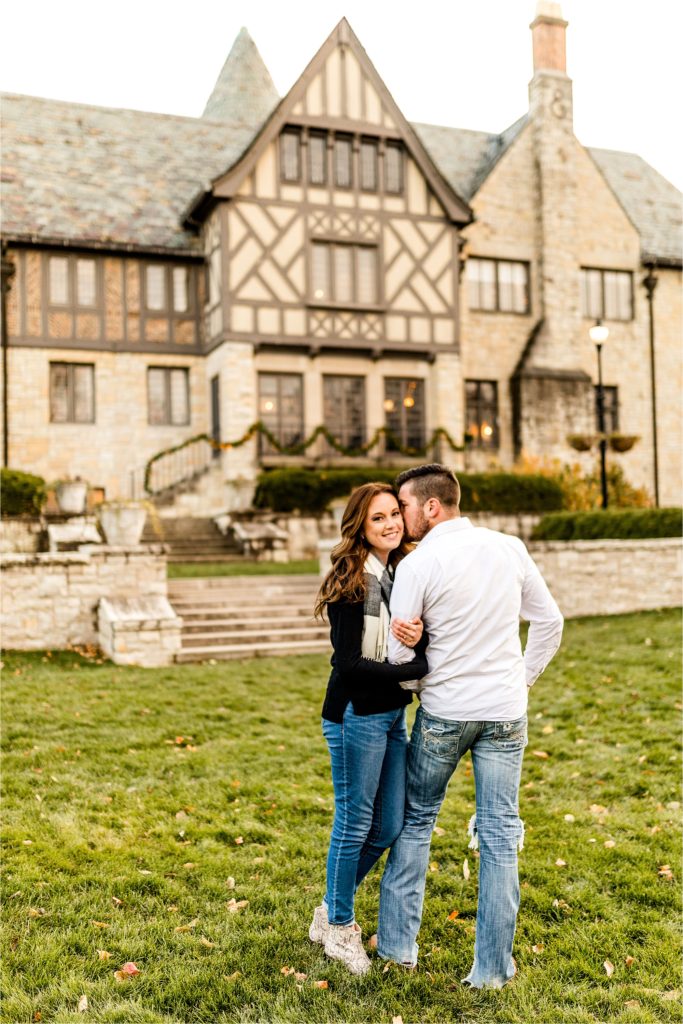
Before we get started, we have a few articles you may be interested in reading whether you’re a photographer looking to build confidence behind the lens or hoping to grow your business, there’s so much more that goes into engagement sessions than simply showing up with a camera. It starts with knowing where to shoot—if you’re stuck on that, take a peek at how we choose engagement photo locations to suit each couple’s vibe. From there, understanding advanced posing techniques can make a huge difference in helping couples feel connected and relaxed. And if you’re looking to book more of these sessions, don’t miss our guide on how to get wedding photography clients and level up your visibility with SEO strategies for photographers!
Understanding the Importance of Client Direction in Photography
Ever notice how some engagement photos look stiff and posed, while others capture genuine moments that feel like you’re peeking into a couple’s real love story? The difference often comes down to one crucial skill: client direction. As engagement photographers, our technical abilities with lighting and composition matter—but the magic happens when we can guide couples into creating authentic moments together.
Client direction isn’t just about telling people where to stand—it’s about creating an environment where beautiful moments can unfold naturally. When I first started shooting engagement sessions, I focused entirely on camera settings and poses. My photos were technically correct but lacked soul. Everything changed when I realized that natural engagement photography depends on how well I could guide my clients while making them feel completely at ease.
Recent surveys show that 56% of clients worry about not being photogenic or knowing how to pose, while 43% feel nervous before their photography session. This anxiety often leads to stiff posing and forced smiles that can ruin otherwise perfect images. Effective client direction tackles this challenge head-on by giving couples something to focus on besides their nervousness about being photographed.
The difference between a good engagement photographer and a great one isn’t just technical skill—it’s the ability to direct clients in ways that reveal their authentic connection. When couples look back at their engagement photos, they should remember how they felt during that moment, not how awkwardly they were positioned.
The Role of Communication in Creating Picture-Perfect Moments
Clear communication is the foundation of memorable engagement sessions. Before I even pick up my camera, I make sure to understand what success looks like for my couples. Do they want dreamy, romantic images? Playful, adventurous shots? Understanding their vision helps me tailor my approach specifically to them.
According to a 2024 survey, 64% of clients reported that clear communication and guidance on posing made them significantly more comfortable during photography sessions. During the session, I’ve learned to provide guidance without micromanaging. Instead of saying “put your hand here, tilt your head this way,” I might suggest: “Whisper something that will make her laugh” or “Take a moment to think about your first date.” This style encourages genuine reactions rather than manufactured poses.
I’ve found that explaining the “why” behind my directions helps tremendously. When clients understand that I’m asking them to walk together because movement creates natural body language, they’re more likely to trust the process and relax into authentic moments.
Building Trust and Rapport with Clients
Trust doesn’t start on shoot day—it begins from our very first interaction. I build rapport by showing genuine interest in my couples’ stories during consultation calls, remembering personal details they’ve shared, and responding quickly to their questions. These seemingly small actions lay the groundwork for natural engagement photography later.
The data backs this up: 67% of clients said photographers who took time to get to know them personally helped them feel more at ease during sessions. One technique that’s transformed my practice is meeting for coffee before the session whenever possible. This casual setting allows couples to see me as a person first, photographer second. By the time we’re on location with a camera, we’ve already built a comfortable dynamic that shows in their photos.
Pre-Session Preparations for Successful Client Engagement
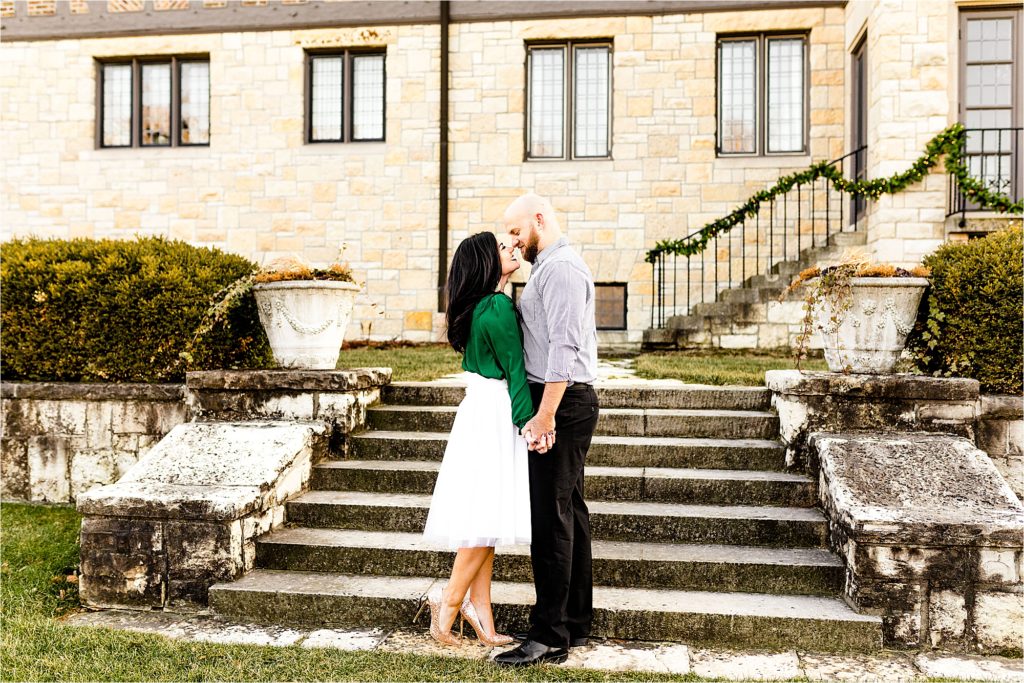
Creating natural engagement photography often involves thoughtful preparation well before we start shooting! While spontaneous interactions make for fantastic images, they frequently arise from careful planning.
Getting to Know Your Clients: Their Story, Preferences, and Expectations
Every couple has a unique story, and understanding that narrative is essential to capturing authentic images. I start this discovery process with a detailed questionnaire that goes beyond basic logistics. I ask about how they met, their favorite date spots, what makes them laugh together, and even their individual love languages. These insights help me tailor my approach to their specific relationship dynamic.
A pre-session consultation has become non-negotiable in my workflow. This approach is backed by research showing that 67% of clients felt more at ease with photographers who took time to get to know them personally. During this meeting (whether virtual or in-person), I observe how couples interact naturally. Do they finish each other’s sentences? Is one more reserved while the other is outgoing? These observations inform how I’ll direct them later. One couple told me, “We felt like you already knew us before the session even started,” which is exactly the comfort level I aim for.
We also use this time to manage expectations by sharing examples of our work and explaining our approach to visual storytelling. This transparency helps align everyone on the style before the session and minimizes surprises later!
Location Scouting and Planning Your Shots
Location selection can make or break an engagement session. Rather than choosing locations based solely on aesthetics, I encourage couples to select meaningful places that tell their story. The coffee shop where they had their first date or the hiking trail they frequent together will evoke genuine emotions that translate beautifully on camera.
Industry data backs this approach, with 76% of clients saying choosing the right location that they feel relaxed in was crucial for photo session comfort. Before each session, I physically visit the location at the same time of day we’ll be shooting. This allows me to find the best light pockets, interesting backgrounds, and potential challenges. I take test shots and notes on my phone, creating a loose shot list that includes must-have captures while leaving room for spontaneous moments.
Planning for 3-4 specific “anchor shots” at each location can give the session structure without feeling rigid. For instance, we might plan for a beautiful sunset silhouette, a sweet interaction near interesting architecture, or a playful moment outdoors. This approach helps us capture portfolio-worthy images while keeping the session flowing naturally!
Designing a Session Timeline that Maximizes Creativity
Creating an effective engagement session timeline is both art and science. I typically plan for a 2-hour session that begins 1.5-2 hours before sunset golden hour light to capture the most flattering light. This timing isn’t random—experience shows that couples tend to relax and show more authentic emotion after the first 30 minutes of shooting, making the golden hour period perfect for those intimate, connected moments.
I structure my timeline to progress from more posed to increasingly relaxed interactions. We might start with some gentle guidance and “posing with purpose” to help the couple get comfortable, then gradually transition to prompts and activities that generate natural moments. This progression mirrors the natural arc of the couple’s comfort level throughout the session.
Effective Communication Tips for a Smooth Photo Session
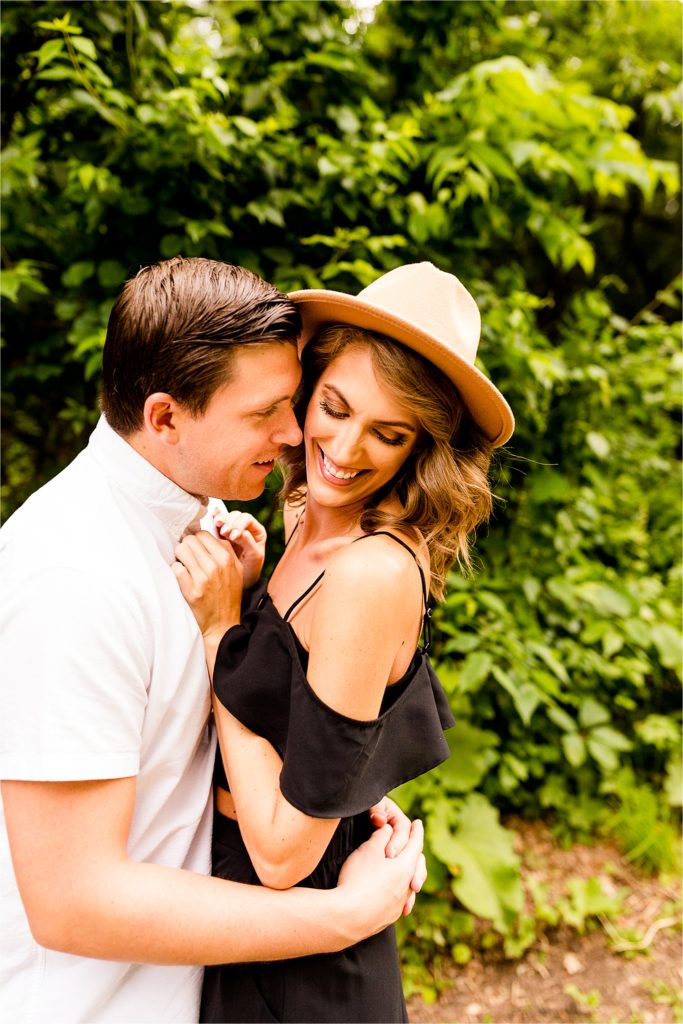
How we communicate with our clients during a session matters immensely! The right words, delivered with kindness and confidence, can help turn potentially awkward moments into a joyful experience that yields wonderful, authentic images.
Using Positive Reinforcement to Create a Relaxed Atmosphere
I always start my session with a deliberate shift in energy. Before taking even one photo, I spend 5-10 minutes in casual conversation, asking about their day or mentioning something I remember from our previous talks. This signals that we’re friends first, photographer and subjects second. Industry surveys show that 89% of photographers use conversation and humor to help clients relax, confirming this approach works well.
Positive reinforcement has become my secret weapon for natural engagement photography. Rather than waiting until I see the perfect pose, I offer encouragement throughout the session. Phrases like “That looks amazing,” “I love how you naturally held her hand just now,” or “The way you look at each other is perfect” reinforce behaviors that create authentic moments and build confidence.
Being specific with praise tends to be more effective. Instead of just saying “You’re doing great,” we might try, “The way you just brushed their hair back looked so sweet and natural—that’s exactly the kind of genuine interaction we hope to capture!” This specific feedback helps couples understand what’s working well and encourages more of those natural responses!
Demonstrating Poses to Help Clients Feel Comfortable and Natural
Effective posing guidance begins with showing rather than telling. When I introduce a new position or concept, I briefly demonstrate it myself or with an assistant rather than just describing it verbally. This visual approach eliminates confusion and gives couples a clear picture of what I’m envisioning without requiring them to translate my words into physical actions.
Professional data shows 76% of photographers provide clear posing instructions and demonstrations to help clients feel comfortable, confirming this works. I’ve developed what I call “foundation posing with freedom.” I establish a basic framework (like how they’re standing relative to each other) but then give them freedom within that structure. For example, I might say, “Start with your bodies close together, but then interact however feels natural—touch her face, whisper something funny, or just look at each other.” This balance of structure and spontaneity creates poses that look both polished and authentic.
Movement has revolutionized my posing guidance. Static poses rarely yield natural-looking results, so I incorporate constant movement in my direction. Simple prompts like “Walk slowly toward me while telling her about your first date” or “Dance together like you’re alone in your living room” create dynamic interactions that photograph beautifully. The movement itself relaxes clients and produces more genuine expressions than standing still ever could.
Direction Cheat Sheet: 15 Proven Prompts for Natural Engagement Photos
Based on hundreds of engagement sessions, here are my most effective direction prompts that consistently produce authentic moments:
- For creating movement:
- “Hold hands and walk towards me, bumping hips as you go”
- “One partner walk slightly ahead, gently pulling the other along”
- “Run towards each other and embrace like you haven’t seen each other in years”
- For capturing playful interactions:
- “Whisper your worst joke in their ear”
- “Have a piggyback ride race towards the camera”
- “Take turns telling each other what you first noticed about them”
- For intimate moments:
- “Put your foreheads together and sync your breathing”
- “Close your eyes and think about your wedding day, then open and share what you imagined”
- “Whisper what you love most about your partner”
- For natural expressions:
- “Tell each other the story of your first date, taking turns adding details”
- “Dance together with no music—one of you has to hum your favorite song”
- “Pretend you just got engaged right now”
- For capturing connection:
- “Take a moment to just look at each other and think about your journey together”
- “Hold hands and take three deep breaths together”
- “One partner tell the other a secret and capture their reaction”
These prompts create genuine interactions rather than posed moments, resulting in images that truly reflect the couple’s unique connection.
Balancing Artistic Vision and Client Comfort
The most beautiful image in the world isn’t worth creating if it makes my clients uncomfortable. I regularly check in throughout the session with questions like, “How are you feeling about everything so far?” or “Is there anything you’d like to try?” These check-ins give couples permission to speak up if something doesn’t feel right and shows that their experience matters as much as the final photos.
Communication should be a two-way street. While I have an artistic vision, I stay flexible and open to clients’ ideas during the session. Some of my most stunning images have come from unexpected suggestions from couples who suddenly felt inspired in the moment. This collaborative approach gives them ownership of the experience and typically results in photos they connect with more deeply.
We often use a “comfort-creativity continuum” approach. Starting with simpler, more conventional poses helps build client confidence. Then, we can gradually introduce more creative or expressive concepts as the session unfolds. By the time we suggest something more artistic or intimate, hopefully enough trust has been built that couples feel secure trying it! This progressive method respects both our creative goals and their comfort boundaries.
Behavioral Cues and How to Direct Different Personalities
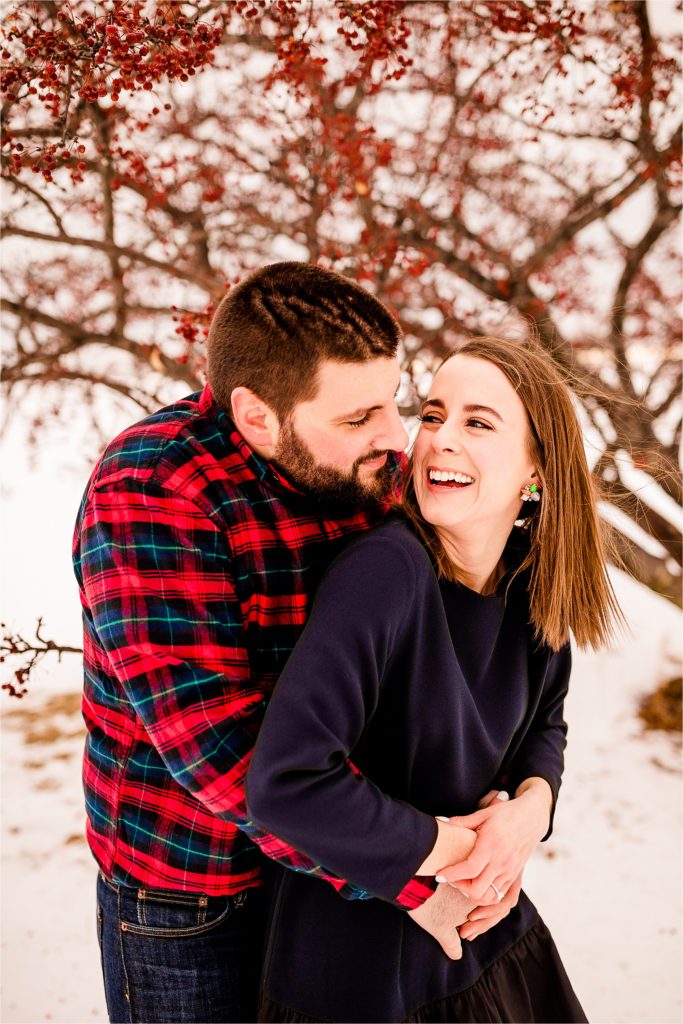
Reading people might be the most underrated skill in a photographer’s toolkit. While technical knowledge helps us create beautiful images, understanding behavioral cues allows us to connect with our clients on a deeper level. Over the years, I’ve developed an approach that adapts to couples’ unique personalities, resulting in images that truly reflect who they are together.
Adapting Your Direction Style for Introverted vs. Extroverted Clients
One of the first things I assess during my pre-session consultation is where couples fall on the introversion-extroversion spectrum. This information fundamentally shapes how I communicate during the session. Introverted and extroverted clients respond to drastically different direction styles, and missing these cues can mean the difference between stiff, uncomfortable photos and naturally beautiful ones.
For my introverted clients, I’ve found that creating physical and emotional space works wonders. I’ll often use a longer lens (85mm or 135mm) to give them breathing room while still maintaining communication. My directions become softer, more general suggestions rather than specific demands. Instead of “Look at each other and laugh,” I might say, “Take a moment to connect with each other however feels natural.” This gentle approach allows them to settle into authentic moments without the pressure of performance.
Introverts often need time to process and warm up, so I intentionally start with simpler, less emotionally demanding poses. I might have them walk together or focus on an activity rather than immediately asking for vulnerable expressions. I’ve noticed that my introverted couples often produce the most touching, intimate photos toward the end of the session once they’ve had time to adjust to being photographed.
Extroverted Clients
With extroverted clients, my approach shifts dramatically. These couples typically thrive with more engagement and stimulation. I’ll move physically closer, using wider lenses (35mm or 50mm) that require me to be in their space, creating an energy exchange that fuels their expressiveness. My directions become more specific and action-oriented: “Spin her around three times and then pull her in close for a kiss!”
For extroverted couples, incorporating movement and conversation throughout the session maintains their natural energy. I’ll ask questions about their relationship while they’re posing or challenge them with playful scenarios: “Show me what your first dance might look like!” or “Pretend you just got engaged right now!” This approach harnesses their natural expressiveness and comfort with being the center of attention.
Managing Group Dynamics: Handling Complicated Requests and Needs
Engagement sessions sometimes include friends, family, or pets, adding another layer to the direction process! When managing group dynamics, setting clear expectations beforehand is key. We typically schedule specific timeframes for group photos, letting the couple know when their more private session time will begin.
Occasionally, a well-meaning friend or family member might offer posing advice during the shoot. Instead of dismissing suggestions, which could create tension, we often use an “acknowledge and redirect” approach. We might say, “That’s a fun idea! Let’s keep that in mind after we finish this sequence we had planned.” This validates their input while allowing us to maintain the flow of the session.
When couples have complicated or technically challenging requests, we prefer a consultative approach over a simple yes or no. For example, if they envision sunset silhouettes but the session is midday, we explain the lighting challenges while suggesting alternatives that might capture a similar feeling. Clients usually appreciate understanding the “why” behind our suggestions!
Including pets requires special planning! Animals can be wonderfully unpredictable. We often schedule pet photos early in the session when energy is fresh, bring appealing treats, and suggest having a dedicated friend handle the pet when they aren’t in the shot. Setting realistic expectations is also helpful—sometimes the perfect pet photo happens quickly, sometimes it takes a bit more patience!
The key to managing any group dynamic is maintaining gentle but clear guidance. By establishing ourselves as confident guides while remaining flexible and receptive, we help create an environment where everyone feels included, while keeping the couple’s relationship as the main focus of our session! This balance helps ensure that even with multiple personalities involved, the core purpose shines through.
Addressing Challenges in Real-Time
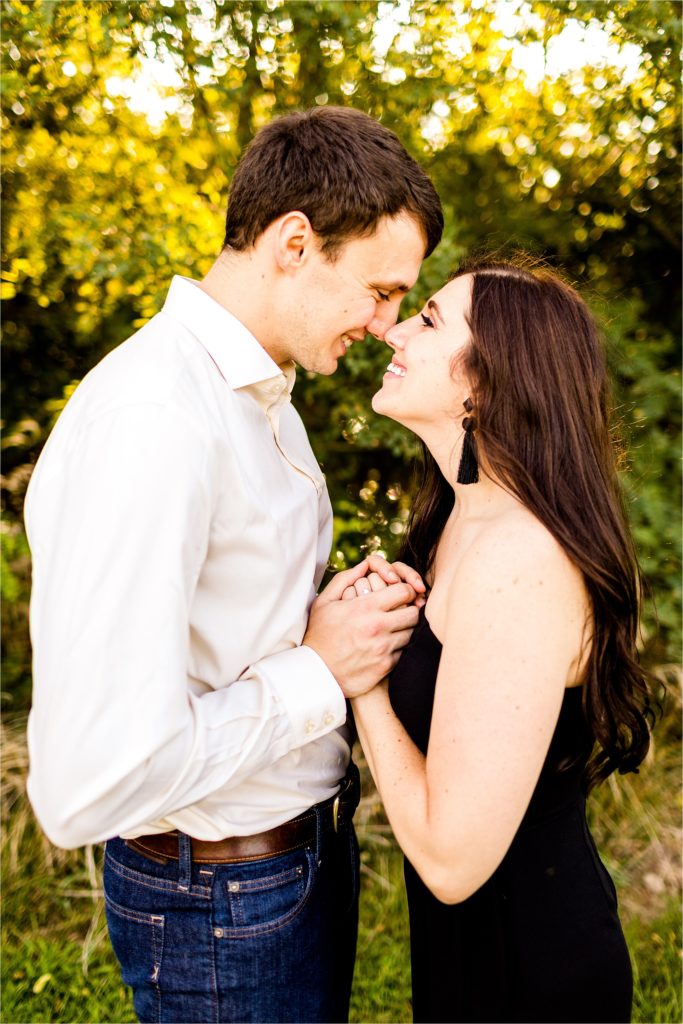
Even the most carefully planned engagement sessions can hit unexpected bumps! What often distinguishes experienced photographers is not whether they face challenges, but how smoothly they navigate them. Developing strategies for common obstacles helps keep the session on track and the experience positive for clients.
Handling Unexpected Weather Conditions or Changes in Locale
Weather remains the most unpredictable element in any outdoor photography session. I’ve learned to embrace rather than fight against unexpected conditions. When rain shower interrupts what was planned as a sunny natural light engagement photos session, I keep transparent umbrellas in my car that can transform a potential disaster into romantic, spontaneous moments. One of my most published images came from a sudden downpour where the couple shared a kiss under a clear umbrella with rain creating a beautiful bokeh effect around them.
Dramatic shifts in lighting conditions require quick technical adjustments. While golden hour provides ideal natural light engagement photos, sometimes clouds roll in unexpectedly. I prepare by knowing exactly how I’ll adjust my camera settings for various scenarios. If gentle golden light suddenly transforms into harsh direct sun, I immediately seek out shaded areas or position couples with the sun behind them to create rim lighting while preserving their expressions. This technical flexibility ensures we create beautiful images regardless of lighting challenges.
Addressing Location Issues and Client Communication
Location access issues can also pop up. Arriving at a planned spot to find it unexpectedly closed requires quick thinking! Having researched a few nearby backup locations beforehand is invaluable. Presenting these alternatives confidently to the couple, highlighting the benefits of each, can turn a potential setback into a minor detour. This preparation often leads to discovering new spots that work out wonderfully!
How we communicate these changes greatly impacts the clients’ experience. Our energy sets the tone! If we treat a change like a major problem, couples might feel disappointed. Instead, framing unexpected shifts positively works much better: “Wow, this new spot has amazing light filtering through the trees! We can get some gorgeous natural light engagement photos here that we wouldn’t have captured at the first location!” This helps couples embrace the change rather than dwelling on the original plan.
Troubleshooting Camera-Shy Clients and Easing Their Nerves
It’s very common for clients to feel nervous about being photographed! Data suggests 56% worry about not being photogenic or knowing how to pose, and 43% feel anxious before their shoot. We address this directly during pre-consultations by acknowledging that feeling awkward is totally normal! Simply validating these feelings often reduces anxiety, as clients realize their discomfort isn’t unusual.
For severely camera-shy clients, I implement a gradual exposure technique. We begin with what I call “zero-pressure poses” where couples interact with each other or their environment rather than the camera. Simple prompts like “Walk along this path together and pretend I’m not even here” allow them to ease into being photographed. As their comfort increases, I gradually introduce more camera-aware moments, carefully gauging their confidence before progressing.
Physical movement serves as a powerful anxiety reducer during sessions. Motion helps dissipate nervous energy while preventing stiff, unnatural posing. For timid couples, I incorporate walking, dancing, or playful activities throughout their session. This strategy not only creates beautiful natural light engagement photos with authentic movement but also helps clients focus on the activity rather than their self-consciousness about being photographed.
Creating a Comfortable Atmosphere and Using Specific Techniques
The atmosphere I create dramatically impacts client comfort levels. I’ve found that maintaining a steady stream of light conversation mixed with specific direction helps nervous couples relax. I share amusing stories from other sessions, ask questions about their wedding plans, or comment on something positive I’m seeing through my viewfinder. This continuous dialogue prevents awkward silences where anxiety can creep back in.
For clients who struggle with genuine expressions, I use what I call the “private moment technique.” I’ll set up a beautiful composition with ideal natural light, then step back and ask them to share something meaningful with each other—perhaps their favorite memory together or why they fell in love. This creates authentic emotional moments while giving them brief respite from feeling watched. I capture these exchanges from a respectful distance using a longer lens, resulting in surprisingly intimate images even with the most camera-shy individuals.
Perhaps one of the most helpful strategies is normalizing imperfection. Showing clients a few nice images on the camera screen during the session can build confidence. We also find it helpful to openly share when we’re adjusting something (“Let’s try that again from this angle for better light!”). This transparency demystifies the process and shows them that creating lovely photos is iterative—they don’t need to get it perfect instantly! This permission to be imperfect often helps them relax into more natural, wonderful interactions.
Post-Session Follow-Up: Building Client Satisfaction and Encouraging Future Engagements
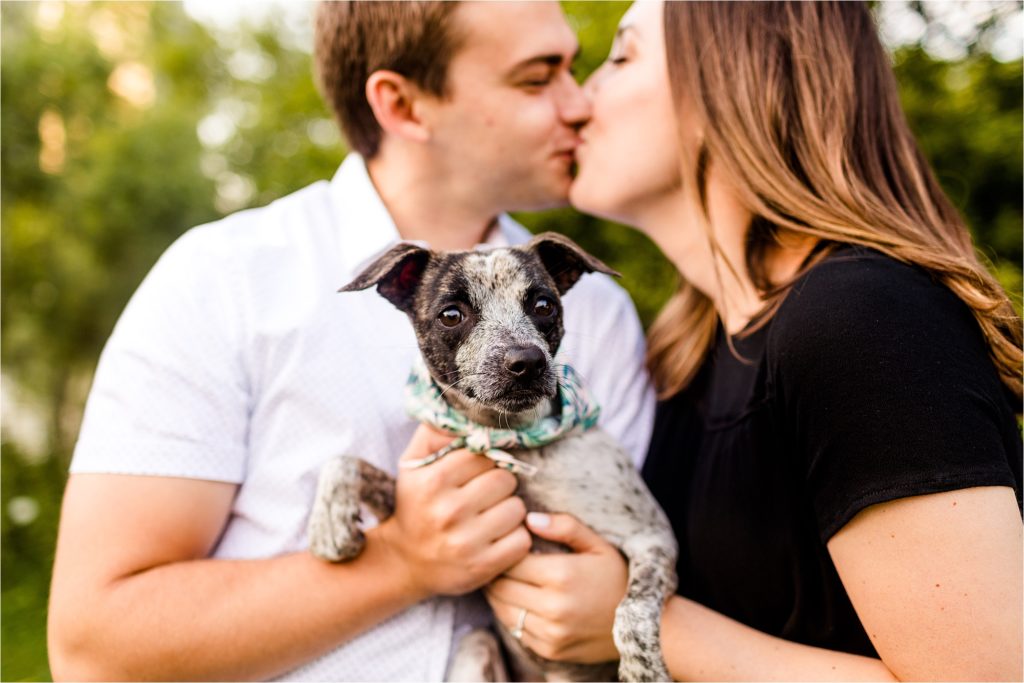
The photographer-client relationship often extends far beyond the photo session itself! How we handle the post-session experience can turn happy clients into enthusiastic supporters of our work. A thoughtful follow-up system can delight couples and help build lasting relationships and valuable referrals.
Reviewing the Photos Together: Gaining Feedback and Insights
The image review process offers a golden opportunity to strengthen client relationships while gathering invaluable insights for your photography portfolio building efforts. Rather than simply delivering digital files, I schedule a dedicated review session either in person or via video call. This approach transforms image delivery from a transaction into an experience that deepens our connection.
During these review sessions, I pay careful attention to clients’ immediate reactions. Which images make them gasp or smile? Which ones do they linger on? These natural responses provide clearer feedback than any questionnaire could. One couple might be drawn to dramatic wide shots while another cherishes intimate close-ups. These preferences inform not just how I’ll approach their wedding photography but also which styles I’ll emphasize with similar couples in the future.
I structure these conversations to balance celebration with honest feedback. Beginning with their favorite images creates a positive atmosphere where they feel comfortable sharing what resonated most. Then I ask thoughtful questions like, “Were there any poses or moments you hoped we’d capture that we missed?” and “Which images feel most like ‘you’ as a couple?” This dialogue provides crucial insights that help me refine my direction techniques while making clients feel genuinely heard and valued.
Providing Teasers and Building Excitement for Final Edits
The post-session period can either build anticipation or anxiety, depending on how you manage it. I’ve found that strategic teaser images serve as the perfect bridge between the session and final gallery delivery. Within 24 hours after our shoot, I select and edit one standout image that showcases the couple at their best. This single image reassures them that beautiful moments were captured, maintains their emotional connection to the experience, and gives them something they can immediately share with friends and family.
Our teaser delivery often includes a brief note about why that particular image stood out. Instead of a generic message, we might write something like: “I absolutely loved how the sunset light enveloped you both during this quiet moment! Your natural connection really came through, and I’m so excited to share the full gallery soon!” This personalized context reminds them of the good feelings from the session and builds positive anticipation.
Being transparent about the editing timeline is also very important for managing expectations. Providing a clear timeframe for when they can expect the full gallery helps prevent anxiety. Knowing when their images will arrive builds trust and avoids the frustration of uncertainty! This positive experience also benefits photography portfolio building, as happy clients who receive timely teasers are more likely to share them, organically expanding visibility.
Creating Opportunities for Future Engagements and Referrals
Every engagement session client represents potential for multiple future bookings: their wedding, anniversary sessions, eventual family portraits, and referrals to friends. I approach this potential deliberately by creating structured opportunities for continued engagement. Within my final gallery delivery, I include a personalized “next steps” guide that outlines future sessions they might consider, along with any loyalty benefits they’ve earned.
Referrals are incredibly valuable for photography business growth; businesses with high client satisfaction often see strong referral rates (sometimes reported between 70-80%). The timing of asking matters! Requesting referrals when client excitement is high—usually shortly after gallery delivery—can significantly increase success. A simple referral program offering mutual benefits (like print credits for both the referring couple and their friends upon booking) creates a positive incentive.
Using technology thoughtfully helps maintain connections. Client management systems can automate anniversary congratulations or seasonal session reminders. These gentle touchpoints keep us top-of-mind without being intrusive. Receiving an anniversary message featuring a favorite engagement photo often sparks interest in booking again or recommending us!
Above all, treating every client interaction as a chance to show our commitment to their happiness is key. When occasional issues arise, addressing them promptly and generously builds immense goodwill. Businesses focusing on client retention often see significant benefits, as loyal clients can contribute substantially more over time than new ones. By making the post-session experience a relationship-building opportunity, we foster organic photography portfolio building through client advocacy – often the best promotion there is!
Continuous Improvement: Learning from Each Photography Session
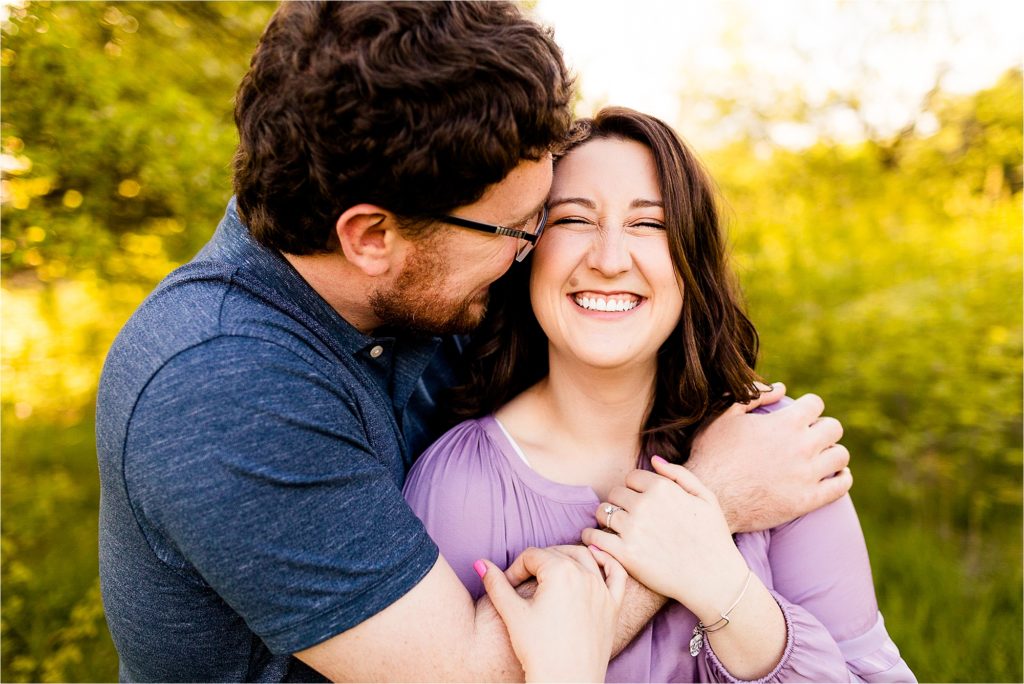
Growth in photography comes from intentional reflection and adaptation! True development often stems not just from equipment or social media presence but from approaching each session as a chance to both create lovely images and learn something new.
Reflecting on Each Session to Improve Client Direction Skills
Some of the most valuable learning happens shortly after an engagement session concludes! Developing a post-session review ritual can significantly accelerate growth. Within 24 hours of a shoot, setting aside even 30 minutes to reflect on what went well and what could be approached differently next time is incredibly helpful. This reflection focuses heavily on client interactions and direction techniques.
During this reflection, we ask specific questions: Which prompts seemed to elicit the most natural reactions? Were there moments clients seemed unsure about our direction? Did we notice any non-verbal cues suggesting discomfort that we could address sooner next time? This systematic analysis turns each session into a practical learning opportunity for refining our engagement photo tips and direction skills!
Reviewing the images critically also provides valuable insights. Are couples appearing stiff in certain types of poses consistently? Is there enough variety in expressions? This visual feedback can reveal patterns or areas for improvement in our direction that weren’t obvious during the live session. For instance, noticing a lack of tender, quiet interactions might prompt us to consciously add more prompts for those types of connections.
Recording audio during sessions (always with explicit client permission!) can be an instructive, albeit sometimes humbling, tool. Listening back to our own direction can reveal vague language, rushed instructions, or missed opportunities for encouragement. This review process helps develop clearer, more effective direction cues!
Keeping Up with Trends and Innovations in Engagement Photography
Engagement photography styles evolve, influenced by fashion, social media, technology, and culture. Staying current helps us create relevant images and meet clients’ expectations! We find dedicating regular time (perhaps a few hours monthly) to research trends and test new techniques keeps our approach fresh and appealing.
Industry trends show that engagement photo styles now change more rapidly than in previous decades. To stay ahead of these shifts, I follow a diverse range of photographers on platforms like Instagram and Pinterest, not just those in my niche. This broader exposure helps me identify emerging styles before they become mainstream. Currently, I’m seeing a significant move toward more journalistic, candid engagement photos with minimal posing—a shift from the highly directed, editorial style popular just a few years ago.
Educational investment has been crucial to my development. I participate in at least two workshops annually and maintain subscriptions to several online learning platforms. These resources expose me to new engagement photo tips and techniques from photographers with different backgrounds and perspectives. After learning a new approach, I practice it extensively before incorporating it into client sessions. This testing phase ensures I can execute new ideas confidently when it matters most.
Technology has transformed how I capture and deliver engagement photos. I regularly evaluate new tools like smartphone apps for location scouting, client management systems for streamlining communication, and editing presets for developing consistent styles. However, I’m careful to adopt only technology that genuinely enhances the client experience or image quality—not every innovation deserves incorporation into a professional workflow.
Encouraging Client Testimonials to Build Your Photography Portfolio
Client testimonials are foundational for photography portfolio building! Authentic words from happy couples often carry more influence than traditional marketing. Many couples consider testimonials when choosing photographers, making positive reviews a highly valuable asset.
We’ve found our testimonial collection process works best when we ask specific, targeted questions rather than just a general “How was it?”. Questions like, “What part of our session together pleasantly surprised you?” or “How did the guidance provided make you feel during the shoot?” tend to elicit detailed feedback highlighting unique strengths.
Timing the request is also effective. The ideal window seems to be 3-5 days after delivering the final gallery, while excitement is still high! Framing the request gently helps too: “Sharing your experience could really help other couples who might be nervous about photos feel more confident!”
Offering multiple ways for clients to share feedback (email, social media, video) accommodates different preferences and often increases participation. Testimonials that mention specific details about the direction style and how it fostered comfort are particularly impactful for photography portfolio building. Stories from clients who were initially anxious but ended up enjoying the process resonate strongly with prospective clients facing similar feelings! Featuring these transformation stories prominently shows that even camera-shy couples can have a wonderful experience with supportive guidance.
Continuous improvement allows us to better serve the couples who entrust us with their important memories. By systematically reflecting, staying current, and gathering meaningful feedback, we enhance not just our images, but the entire experience we offer! This dedication fosters growth and helps create positive experiences that clients will appreciate and share.
Affiliate Disclosure: Some links in this post are affiliate links, meaning we may earn a commission if you make a purchase through our links, at no extra cost to you. As wedding photographers ourselves, we only recommend gear we’ve thoroughly researched or would use in our own business. Your support helps us continue creating valuable content for the photography community.